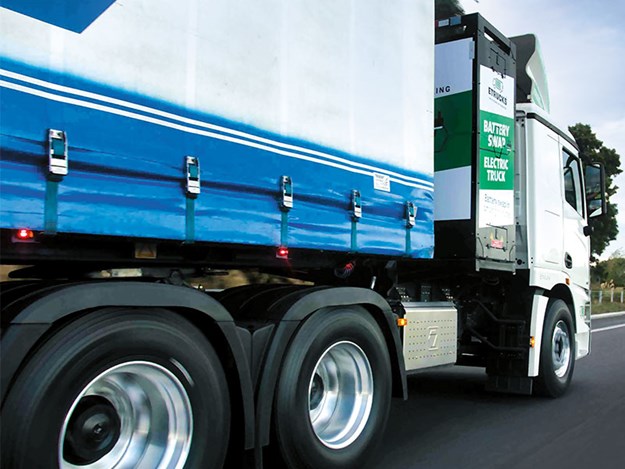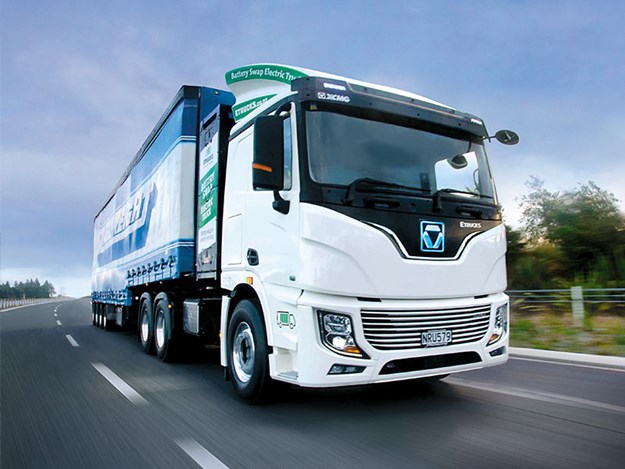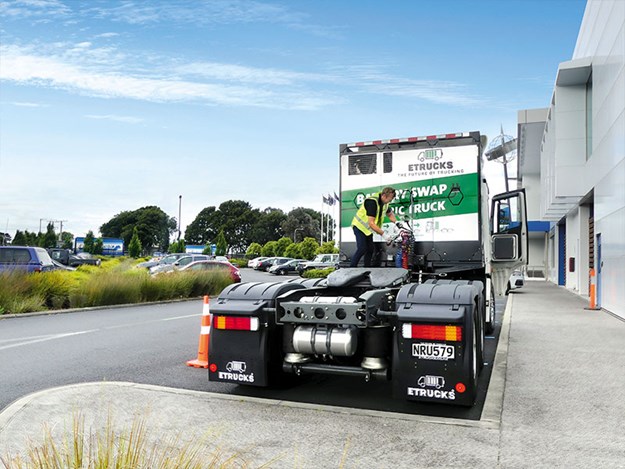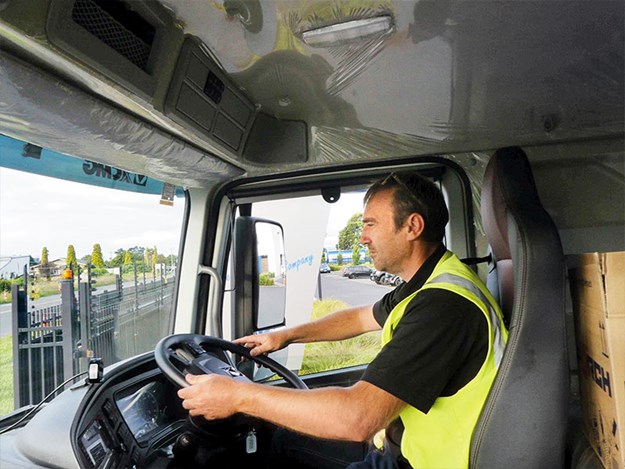Cover story: Etrucks XCMG E700
The future of heavy truck electric trucking is here, as the XCMG E700 does a fully loaded test run from Auckland to Hamilton
Since the initial ride-along I had with ETrucks owner/director Ross Linton (DOW 340), Ross and his team have been busy carrying out a number of tests with the truck, towing a selection of loads of varying weights and trailer-axle configurations.
These tests included calculating the amount of ‘regen’ gained on a downhill run on the likes of Auckland’s Bombay hills, along with confirming their expectations of the level of residual power left in the battery at the end of a relatively long haul.
 |
|
The only sound when passing the truck was the whirr of tyres on the road
|
Things have obviously moved along quite quickly over the past half-year, something that’s evidenced even in the thought process of a mind as innovative as Ross Linton’s.
While driving us along an Auckland motorway and back down a few city streets in the prime-mover as part of last year’s story, it was clear that Ross was excited about the prospects for battery-powered heavy-duty vehicles as being a viable option to their diesel-powered counterparts.
But even the man who’d made dozens of trips to the XCMG factory in China in order to finally bring the right-hand-drive compliant big rig to New Zealand shores believed that he was only contemplating relatively short hauls for the E700 at that point in time.
"While initial interest in the E700 was metro, we have two customers who always intended to do intercity. Indeed, we have had discussions for Hamilton to Auckland for nearly two years now. There was a delay because we wanted to add super single front wheels. That took time for compliance, as they aren’t used in China and further tests had to be carried out," says Ross.
"A further delay in doing the tests was the second Auckland lockdown and reluctance for unnecessary border crossings. That’s why we waited until an actual freight run could be achieved, not just a loaded ‘test’," he says. "The test runs are actually a bit ahead of XCMG’s published data."
On the road
 |
|
The Auckland–Hamilton leg with 41 tonnes gross consumed $31 worth of energy/fuel
|
Fast forward a mere six or so months, and here we were about to do a run from Hamilton up to Auckland with an all-up weight of around 40 tonnes.
Several weeks prior to this particular trip, Jamie Ryan, ETrucks’ general manager had driven the truck in the opposite direction with a gross weight of 41 tonnes, towing one of Mainfreight’s quad-axle trailers, producing some interesting fuel economy stats to show at the end of the run.
On the Auckland–Hamilton run, the truck’s 282kWh LFP (lithium ferrous phosphate) swappable battery used 66% of its power over a trip that measured 108km.
It’s interesting to note that on the downhill run on the Bombay Hills, south of Auckland, a two-fold effect was achieved with the truck being allowed to do its own regeneration braking at a speed of approximately 80km/h, with the by-product being that four percent of charge going back into the battery.
The return trip Hamilton–Auckland produced some slightly different figures with a gross weight of 36 tonnes, again with a Mainfreight quad-axle in tow. Jamie got back to Auckland with 39% battery remaining.
These figures equate to a possible 150km delivery trip, still retaining the recommended 15% residual power, assuming a gross weight of 36 tonnes travelling at a maximum speed of 90km/h.
Note: With the battery having been placed on charge during off-peak hours the night before the run, the Auckland–Hamilton leg with 41 tonnes gross consumed $31 worth of energy/fuel.
 |
|
Setting up the trailer couplings is the same as a conventional rig
|
It still has to be emphasised that even with the latest battery technology on offer, with the E700, you still only get 120 to 150km out of one charge, assuming a gross weight of around 40 tonnes with a vehicle governed to 90km/h.
But the pièce de resistance of the ETrucks battery swap system is that once set up at strategic locations, specialised automated gantries have the ability to do a complete changeover in less than five minutes.
A residual charge of a minimum of 15% is recommended in order to preserve battery quality and cell life, aside from preventing the steep reduction, which occurs in the energy curve that would eventually result in the electric motor placing the truck into ‘limp mode’ if allowed to run too low.
The country’s first robotic battery transfer station is scheduled to open in Auckland at a yet-to-be specified location and is expected to be up and running by the middle of 2022.
"This will allow a variety of ownership models for the batteries. In time, an option similar to the ‘swap a tank’ for your barbecue LPG tank will be available. That will lower the purchase price of the truck considerably and each charged up swap battery will still cost less than the equivalent amount of diesel," says Ross.
Of course, those businesses who only require short daily hauls can purchase their own battery, which can be charged over varying timeframes via three-phase AC or DC systems.
The fastest charging on truck charger available at present is 120kW DC for roughly two hours charge time, assuming the battery has a 20% charge remaining.
If a longer charging time is selected, then a 7kW AC charger would take around 35 hours to achieve the same results.
A driver’s perspective
 |
|
Jamie Ryan heading north with 36 tonnes all up
|
ETruck’s general manager Jamie Ryan is the guy in the company who drew the long straw in this case and temporarily swapped his managerial role to become the official truck driver/tester.
The DOW ride-along on the Hamilton to Auckland leg of the test provided the perfect opportunity to nestle into the passenger’s seat for a while to not only ask Jamie some questions but also observe his body posture and facial expressions as we clipped along the highway with an all-up weight of 36 tonnes on the road.
Of course, this trip wasn’t only about testing the E700’s ability to tow a load uphill and down dale, so it was felt that a few questions about setting up the rig in Mainfreight’s Hamilton yard would be in order.
Here’s a recap of our quick Q&A session while on the road.
DOW: Any differences connecting the trailer between the E700 and a conventional rig?
Jamie: Not really, just that instructions from co-workers are easier to hear with no idling engines to talk over.
DOW: I noticed that you dropped the air suspension to get under the trailer. Do all E700s have air suspension?
Jamie: Yes, they do.
DOW: How many kilometres on the clock right now?
Jamie: 2122km
DOW: You must’ve driven it for a couple of thousand of those. Have you ever felt the need to override the six-speed auto by using the Tiptronic feature?
Jamie: No mate, the gearbox changes when it needs to. That lever is really only there to make the truck go forwards or backwards. I reckon the Tiptronics there for the benefit of those drivers who get bored with just steering the rig and find themselves wanting to do a bit of driving.
DOW: We’ve been on the road for quite a few hours now if we include the drive down to Hamilton plus the loading time, you look comfortably relaxed about the whole affair.
Jamie: Remains silent with just a huge grin on his face
As I climb down from the truck and hop in my car to head on home, I can’t help but notice the inspirational message on the back of the Mainfreight trailer we’ve been towing on the run, it says it all really.
For more information, visit etrucks.co.nz.
Find new and used trucks for sale in NZ
Keep up to date in the industry by signing up to Deals on Wheels' free newsletter or liking us on Facebook.





.jpg)


.jpg)


.jpg)
.jpg)
.jpg)
.jpg)

